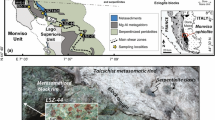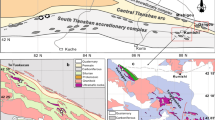Abstract.
We examine the O–H isotope signatures of Alpine ultramafic rocks and eclogitic metagabbros of the Erro–Tobbio peridotite Unit (western Italian Alps), which record a subduction and exhumation cycle. Localization of subduction-related deformation along serpentinite mylonite shear zones favoured preservation of pre-subduction mantle and low temperature (oceanic) alteration assemblages within undeformed (meta)peridotite that underwent partial static recrystallization to high-pressure metamorphic parageneses. Bulk rock and mineral separate (clinopyroxene and serpentine) oxygen isotope ratios of the serpentinized mantle peridotites (5–8‰) are slightly enriched in 18O compared with those of the high-pressure metaperidotites and the serpentinite mylonites (4.4–7.6‰). The lowest values occur in high-pressure veins (3.5–5.7‰) and eclogitic metagabbros (3.1–5.3‰). These variations are comparable to variations observed in modern oceanic rocks and in non-subducted ophiolites. Preservation of pre-eclogitic δ18O signatures of the Erro–Tobbio rocks and a lack of oxygen isotope re-equilibration between different shear zones imply local-scale fluid flow at low water/rock ratios and closed system behaviour during high-pressure metamorphism. Different serpentine generations show a bimodal distribution in δD values: pre-eclogitic lizardite and chrysotile range from –102 to –77‰; high-pressure antigorite in the mylonites and in low strain metaperidotites range from –71 to –57‰ and –83 to –60‰, respectively. Comparable ranges occur in antigorite in the associated high-pressure veins, suggesting that the hydrogen signatures were acquired prior to veining. We propose that the isotopic variations reflect multiple events of fluid uptake in different geodynamic environments. The H- and O-isotope ratios in the eclogitic mylonites suggest that initial hydration occurred over a range of temperatures during local interaction with altered seawater along oceanic shear zones. The 18O-enriched and H-depleted compositions of chrysotile and lizardite in the mantle peridotites suggest that a second hydration event may have occurred as a result of interaction with metamorphic fluids at the early stages of burial in a forearc setting, where slabs undergo large-scale, low-temperature fluid fluxing. The oceanic mantle is thus a candidate for continuous hydration during its oceanic and early subduction history. The Erro–Tobbio unit thus represents an example of cycling of internally-derived fluids, whereby the different structural and textural domains behaved as relatively closed systems to fluid circulation during high-pressure metamorphism.
Similar content being viewed by others
Author information
Authors and Affiliations
Additional information
Electronic Publication
Rights and permissions
About this article
Cite this article
Früh-Green, G.L., Scambelluri, M. & Vallis, F. O–H isotope ratios of high pressure ultramafic rocks: implications for fluid sources and mobility in the subducted hydrous mantle. Contrib Mineral Petrol 141, 145–159 (2001). https://doi.org/10.1007/s004100000228
Received:
Accepted:
Published:
Issue Date:
DOI: https://doi.org/10.1007/s004100000228




